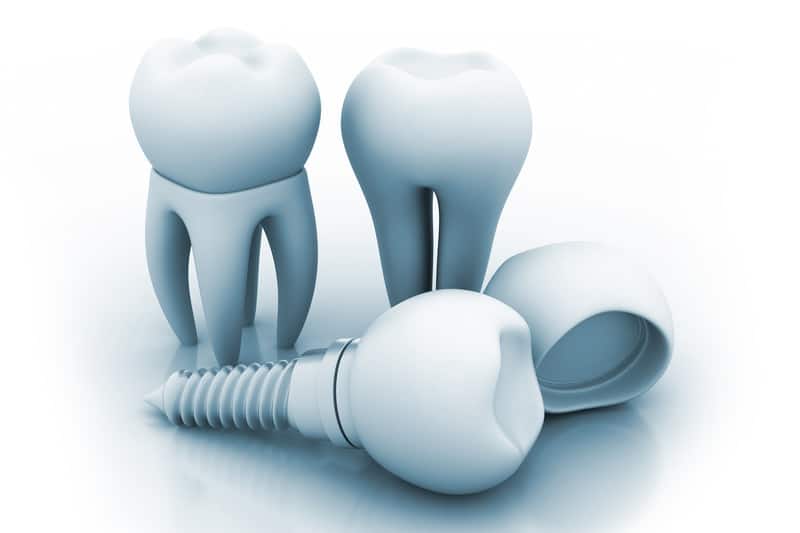Are you curious to find out how dental implants work? All In One Dental Innovations is ready to thoroughly explain dental implants and their performance as long-term tooth replacements. You can also read our implant guide to learn more!
The Different Parts Of A Dental Implant
Although a dental implant is meant to act as an artificial replacement for natural teeth, implants are composed of similar parts–a “root” and “crown.” These two parts are joined together with a connector piece called an abutment.
The root of the tooth implant is generally composed of a metal material like titanium because of its durability. This metal “root” is shaped in the form of a screw that can be tightly installed into the jawbone of the patient or, in some cases where patients have shallow jawbones, into the gums. The ridges of the screw, along with a special bone growth-promoting substance coating the screw, allow the bone to heal perfectly around the implant. The bone and gum tissue must heal properly around the implant to be held in place without the risk of later maladjustment.
The crown is often composed of porcelain for a natural-looking finish that replicates the appearance of a natural tooth. Artificial crowns can also be composed of metal materials or a mixture of metal and porcelain, depending on a patient’s budget and preferences. Porcelain crowns are fairly sturdy and, similarly to the implant’s root, also have a special coating; however, the coating on a crown protects it from potential issues like staining. So long as the crown is regularly cared for with proper hygiene techniques, it will continue to resist these minor damages. Crowns can also be created with a custom shade to match the patient’s other teeth, which makes them look even more natural.
The abutment can comprise several materials, including gold, other metals, or porcelain. This part of the implant is highly important in its contribution to the structural design of the whole dental implant. The abutment securely fits into the metal post of the implant and rests just above the gums to provide a stable connection to the implant’s crown. By attaching an abutment piece to the implant, the gums have time to heal after the initial installment of the metal post into the jawbone, and the abutment provides a stable platform for a permanent crown to be placed later on.
How Does A Dental Implant Function?
With the same functional capabilities as a natural tooth, a dental implant allows the patient to eat, speak, and smile normally. The missing, rotting, or otherwise damaged teeth that implants replace can cause increasing harm to a patient’s overall health. By removing and replacing them with implants, health risks are lowered, thus allowing the patient to focus on improving their dental health rather than preserving it.
Implant dentists devote time and effort to pairing patients with the best implant materials suitable for them to ensure the patient’s comfort as well as the implant’s success. The permanent artificial crowns that top the implant are custom-designed to fit perfectly alongside the patient’s other teeth to align the teeth properly. Dental pieces that don’t properly fit the patient can cause crowding, pain, and implant failure.
Take a look at what the AAID has to say about the benefits of dental implants:
“Here is why you will enjoy dental implants: Missing teeth restored with dental implants look, feel, and function just like natural teeth. You brush, floss, and visit your dentist for regular check-ups and cleanings, the same as you would to care for a natural tooth.”
Along with restoring a smile, a dental implant’s crown allows the patient to break down food without discomfort or pain safely. The presence of the implant will also allow the patient to speak regularly without any insecurities about their teeth or whether they will have a lisp sound when forming words.
How Implants Perform Over Time
Over time, a dental implant should perform the same as it did when it was first installed. Implants are fairly durable compared to other teeth replacement alternatives like dentures or bridges. Implants require little adjustment or ongoing maintenance outside regular hygienic care, such as brushing, flossing, or rinsing your teeth.
Although implants are durable, they aren’t indestructible and can become susceptible to damage like crown staining or chipping if not careful. The protective coating on an implant crown can wear away over time and expose the porcelain to tinted or acidic food substances that will cause discoloration. Also, a strong impact against the crown can cause chipping and other damages in extreme situations.
If an implant is damaged somehow, it can be easily repaired or replaced, but it isn’t a common necessity for most patients. So long as you follow a normal hygiene routine and monitor changes with the implant, it will continue to perform well over time. Any concerns about the implant or its maintenance should be discussed with your dental health advisor immediately to prevent any hidden issues from further developing.
Stay In Touch
If you have any further questions or information you would like access to regarding dental implants and their function, please take the time to call the All In One Dental Innovations practice today! Our number is (925) 828-9811, and we look forward to hearing from you. You can also request an appointment online!
Related article: Are Dental Implants Permanent?

